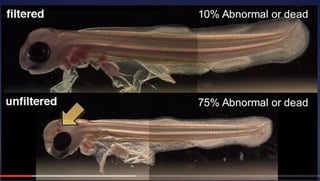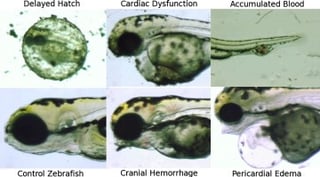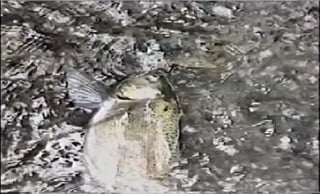
If you read the first post in this series last month, you read that some of the most common sources of stormwater pollutants are from seemingly benign activities such as driving a car or fertilizing a lawn. What is the effect of this stormwater pollution? With the salmon spawning and salmon fishing season upon us, fish are at the top of mind, so it seems appropriate to discuss the effects of stormwater pollution on fish, specifically coho salmon.

Urban stormwater runoff has been thoroughly studied and found to include a complex mixture of metals, petroleum hydrocarbons, elevated hardness, nutrients, suspended solids, dissolved organic matter, propylene glycol (anti-freeze), rubber (vehicle tire wear) and other contaminates (Sansalone and Buchberger, 1997, Shinya et al., 2000, Stein et al., 2006, Aatmeeyata and Sharma, 2010, Rogge et al., 1993, and McIntyre et al, 2014).
More recently, the effects of this stormwater, and the effects of the chemicals in the stormwater, on fish has also been studied. In one such instance, National Oceanic and Atmospheric Administration (NOAA) scientists conducted a study regarding the effects of urban stormwater pollution on coho salmon embryos in particular; the results, as you will read, were sobering.
For the study, the scientists directed water from an urban creek (Longfellow Creek, Seattle) into the laboratory. Half of the water was filtered and the other half left as unfiltered creek water. Coho embryos were raised for 50 days in either the filtered or un-filtered creek water (the water was continuously being replaced during these 50 days). Note that for this study, fish were not raised in stormwater runoff directly from a road or parking lot, but they were raised in the creek water—water from their habitat. At the end of 50 days, 75% of the embryos raised in the unfiltered creek water were either dead or abnormally formed (vs. 10% dead or abnormal in the filtered creek water).

How toxic is stormwater runoff?
In another study, Washington State University Scientists (McIntyre, 2014) studied the effects of urban stormwater on zebrafish embryos (a common species used for laboratory experimentation to rapidly assess effects). Zebrafish embryos (pre-hatch condition) were placed in clean freshwater (control fish) or in highway stormwater runoff (collected from a high traffic volume arterial street in Seattle, Washington). Then the fish were observed through hatching and partial development.
The study showed that 100% of the fish in the stormwater died within 96 hours (versus greater than 96% survival for the control fish). Even at 48 hours most of the fish in the stormwater had sublethal developmental abnormalities such as inability to hatch or delayed hatching, lack of swim bladder inflation, small eyes, fluid on the heart, deformed jaws and congestive heart failure.
To further evaluate the toxicity of the roadway stormwater, zebra fish were raised in solutions of 5%, 10%, and 50% stormwater runoff. Even the fish raised in a solution of 5% stormwater (95% fresh water) experienced several sublethal effects (J. K. McIntyre, 2014). Indeed, urban stormwater is very toxic to fish.

(Photo credit: Zebrafish and Clean Water Technology: Assessing soil bioretention as a protective treatment for toxic urban runoff, Science of the Total Environment, December 2014)
Finally, stormwater’s effect on adult coho salmon has also been studied. In several studies, researchers investigated urban streams that had returning spawning adult coho salmon. They found widespread and recurring deaths of the adult coho salmon that return each fall to spawn in urban creeks in the Pacific Northwest. They found that 63% to 83% of the adult salmon were dying before they had a chance to spawn. The scientific evidence indicates that salmon deaths are caused by the toxic chemical contaminants from land-based urban runoff that ends up in the urban streams during the fall spawning season (Feist et al., 2011) and did not appear to be due to water temperature or dissolved oxygen (Scholz et al., 2011). Before death, the adult fish were disoriented, lethargic, gasping and floating near the top of the water. In contrast, pre-spawn mortality in rate in comparable non-urban streams was found to be less than 1%.

If only about 25% of coho salmon returning to urban streams are surviving to spawning, and 25% of the hatched embryos are surviving, then only about 6% of the potential number of coho salmon spawning in urban creeks are surviving to be juvenile salmon.
Although this is a sobering statistic, there is good news: there are solutions for treating urban stormwater runoff before the runoff gets into the streams. As it turns out, fairly simple Low Impact Development (LID) techniques are very effective at treating urban stormwater runoff to the level that the stormwater runoff is no longer lethal to fish (McIntyre, 2014).
In our next Low Impact Development 101 post we will discuss treatment of urban stormwater runoff with LIDs in more detail.
We hope you use this series to educate your family, friends, and professional networks about stormwater impacts and how LID solutions can help solve them. Please share and get the word out!
Check out the other posts in our Low Impact Development 101 series:
pt 1. The Source of Stormwater Pollution
pt 3. Stormwater Toxicity Solutions - Can it be that simple?
References:
- Aatmeeyata and Sharma, 2010. Aatmeeyata, M. Sharma. Science of the Total Environment Polycyclic aromatic hydrocarbons, elemental and organic carbon emissions from tire-wear
- Feist et al., 2011. B.E. Feist, E.R. Buhle, P. Arnold, J.W. David, N.L. Scholz, PLOS One, 6 (2011), Landscape ecotoxicology of coho salmon prespawn mortality in urban streams
- McIntyre, 2014. J.K. McIntyre, J.W. Davis, J.P. Incardona, J.D. Stark, B.F. Anulacion, N.L. Scholz. Science of the Total Environment. Zebrafish and clean water technology: Assessing soil bioretention as a protection treatment for toxic urban runoff.
- Rogge et al., 1993. W.F. Rogge, L.M. Hildemann, M.A. Mazurek, G.R. Cass, B.R.T. Simoneit. Environmental Science Technology. Sources of fine organic aerosol. 3. Road dust, tire debris, and organometallic brake lining dust — roads and sources and sinks.
- Sansalone, S.G. Buchberger. J Environ Eng, (1997). Partitioning and first flush of metals in urban roadway storm water
- Scholz et al., 2011. Nathaniel L. Scholz , Mark S. Myers, Sarah G. McCarthy, Jana S. Labenia, Jenifer K. McIntyre, Gina M. Ylitalo, Linda D. Rhodes, Cathy A. Laetz, Carla M. Stehr, Barbara L. French, Bill McMillan, Dean Wilson, Laura Reed, Katherine D. Lynch, Steve Damm, Jay W. Davis, Tracy K. Collier. Recurrent Die-Offs of Adult Coho Salmon Returning to Spawn in Puget Sound Lowland Urban Streams (2011).
- Shinya et al., 2000. M. Shinya, T. Tsuchinaga, M. Kitano, Y. Yamada, M. Ishikawa. Water Sci Techno. Characterization of heavy metals and polycyclic aromatic hydrocarbons in urban highway runoff

